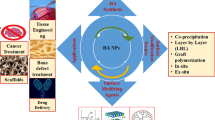Abstract
Hydroxyapatite (HA) has many applications in medicine as a biocompatible and bioactive biomaterial. Numerous studies have shown that modification of the HA surface can improve its biological and chemical properties. However, little is known about the surface properties of modified materials. In this paper the influence of organic polymers: polyethylene glycol (PEG) and polyhydroxyethyl methacrylate (pHEMA) on the surface properties and surface chemistry of hydroxyapatite (HA) is presented. The surface properties of modified HA were characterised by the FT-IR, XPS, BET, and zeta potential measurements. Specific surface area was determined by BET. Infrared and XPS spectra confirmed the presence of PEG and pHEMA on the surface of HA. The BET N2 adsorption revealed slight changes in the HA surface chemistry after grafting modification. The surface chemical properties of the HA were considered to be based on the zeta potential. The decrease in zeta potential results in the increasing stability of the modified material and also in the reduction of bacterial adhesion. The reaction for surface modification of HA is proposed and described.
Similar content being viewed by others
References
Arakaki, M., Yamashita, S., Mutaf, M., Naito, S., & Fuji, T. (1995). Onlay silicone and hydroxyapatite-tricalciumphosphate composite (HAP-TCP) blocks interfere with nasal bone growth in rabbits. The Cleft Palate-Craniofacial Journal, 32, 282–289. DOI: 10.1597/1545-1569(1995)032〈0282:OSAHTC〉2.3.CO;2.
Ciobanu, C. S., Andronescu, E., Stoicu, A., Florea, O., Le Coustumer, P., Galaup, S., Djouandi, A., Mevellec, J. Y., Musa, I., Massuyeau, F., Prodan, A. M., Lafdi, K., Trusca, R., Pasuk, I., & Predoi, D. (2011). Influence of annealing treatment of nano-hydroxyapatite bioceramics on the vibrational properties. Digest Journal of Nanomaterials and Biostructures, 6, 609–624.
Costescu, A., Pasuk, I., Ungureanu, F., Dinischiotu, A., Costache, M., Huneau, F., Galaup, S., Le Coustumer, P., & Predoi, D. (2010). Physico-chemical properties of nanosized hexagonal hydroxyapatite powder synthesized by solgel, Digest Journal of Nanomaterials and Biostructures, 5, 989–1000.
D’Andrea, S. C., & Fadeev, A. Y. (2003). Covalent surface modification of calcium hydroxyapatite using n-alkyl and n-fluoroalkylphosphonic acid. Langmuir, 19, 7904–7910. DOI: 10.1021/la027000s.
Groth, T., Liu, Z. M., Niepel, M., Peschel, D., Kirchhof, K., Altankov, G., & Faucheux, N. (2010). Chemical and physical modifications of biomaterial surfaces to control adhesion of cells (Chapter 13, pp. 253–284). In V. P. Shastri, G. Altankov, & A. Lendlein (Eds.), Advances in regenerative medicine: Role of nanotechnology and engineering principles. Dordrecht, The Netherlands: Springer. DOI: 10.1007/978-90-481-8790-4 13.
Hong, Z. K., Qiu, X. Y., Sun, J. R., Deng, M. X., Chen, X. S., & Jing, X. B. (2004). Grafting polymerization of L-lactide on the surface of hydroxyapatite nano-crystals. Polymer, 45, 6699–6706. DOI: 10.1016/j.polymer.2004.07.036.
Houghton, R. P., & Mulvaney, A. W. (1996). Mechanism of tin(IV)-catalysed urethane formation. Journal of Organometallic Chemistry, 518, 21–27. DOI: 10.1016/0022-328x(96)06223-7.
Jenny, C. R., & Anderson, J. M. (1999). Effects of surfacecoupled polyethylene oxide on human macrophage adhesion and foreign body giant cell formation in vitro. Journal of Biomedical Materials Research, 44, 206–216. DOI: 10.1002/(SICI)1097-4636(199902)44:2〈206::AID-JBM11〉3.0.CO;2-D.
Kinnari, T. J., Esteban, J., Martin-de-Hijas, N. Z., Sánchez-Muñoz, O., Sánchez-Salcedo, S., Colilla, M., Vallet-Regí, M., & Gomez-Barrena, E. (2009). Influence of surface porosity and pH on bacterial adherence to hydroxyapatite and biphasic calcium phosphate bioceramics. Journal of Medical Microbiology, 58, 132–137. DOI: 10.1099/jmm.0.002758-0.
Kłodzińska, E., Szumski, M., Dziubakiewicz, E., Hrynkiewicz, K., Skwarek, E., Janusz, W., & Buszewski, B. (2010). Effect of zeta potential value on bacterial behavior during electrophoretic separation. Electrophoresis, 31, 1590–1596. DOI: 10.1002/elps.200900559.
Liu, Q., de Wijn, J. R., & van Blitterswijk, C. A. (1998a). Covalent bonding of PMMA, PBMA, and poly(HEMA) to hydroxyapatite particles. Journal of Biomedical Materials Research, 40, 257–263. DOI: 10.1002/(SICI)1097-4636(199805)40:2〈257::AID-JBM10〉3.0.CO;2-J.
Liu, Q., de Wijn, J. R., & van Blitterswijk, C. A. (1998b). A study on the grafting reaction of isocyanates with hydroxyapatite particles. Journal of Biomedical Materials Research, 40, 358–364. DOI: 10.1002/(SICI)1097-4636(19980605)40:3⋆358::AID-JBM3〉3.0.CO;2-E.
Liu, Q., de Wijn, J. R., de Groot, K., & van Blitterswijk, C. A. (1998c). Surface modification of nano-apatite by grafting organic polymer. Biomaterials, 19, 1067–1072. DOI: 10.1016/s0142-9612(98)00033-7.
Luo, S. G., Tan, H. M., Zhang, J. G., Wu, Y. J., Pei, F. K., & Meng, X. H. (1997). Catalytic mechanisms of triphenyl bismuth, dibutyltin dilaurate, and their combination in polyurethane-forming reaction. Journal of Applied Polymer Science, 65, 1217–1225. DOI: 10.1002/(SICI)1097-4628(19970808)65:6〈1217::AID-APP17〉3.0.CO;2-Q.
Lu, H. B., Campbell, Ch. T., Graham, D. J., & Ratner, B. D. (2000). Surface characterization of hydroxyapatite and related calcium phosphates by XPS and TOF-SIMS. Analytical Chemistry, 72, 2886–2894. DOI: 10.1021/ac990812h.
Park, J. B., & Bronzino, J. D. (Eds.) (2003). Biomaterials: Principles and applications. Boca Raton, FL, USA: CRC Press.
Qiu, C. F., Xiao, X. F., & Liu, R. F. (2008). Biomimetic synthesis of spherical nano-hydroxyapatite in the presence of polyethylene glycol. Ceramics International, 34, 1747–1751. DOI: 10.1016/j.ceramint.2007.06.001.
Salarian, M., Solati-Hashjin, M., Shafiei, S. S., Salarian, R., & Nemati, Z. A. (2009). Template-directed hydrothermal synthesis of dandelion-like hydroxyapatite in the presence of cetyltrimethylammonium bromide and polyethylene glycol. Ceramics International, 35, 2563–2569. DOI: 10.1016/j.ceramint.2009.02.031.
Shi, D. L. (Ed.) (2004). Biomaterials and tissue engineering. Berlin, Germany: Springer.
Shinto, Y., Uchida, A., Korkusuz, F., Araki, N., & Ono, K. (1992). Calcium hydroxyapatite ceramic used as a delivery system for antibiotics. The Journal of Bone & Joint Surgery, British Volume, 74, 600–604.
Siddharthan, A., Seshadri, S. K., & Sampath Kumar, T. S. (2005). Rapid synthesis of calcium deficient hydroxyapatite nanoparticles by microwave irradiation. Trends in Biomaterials and Artificial Organs, 18, 110–113.
Tanaka, H., Watanabe, T., Chikazawa, M., Kandori, K., & Ishikawa, T. (1998). Surface structure and properties of calcium hydroxyapatite modified by hexamethyldisilazane. Journal of Colloid and Interface Science, 206, 205–211. DOI: 10.1006/jcis.1998.5634.
Author information
Authors and Affiliations
Corresponding author
Rights and permissions
About this article
Cite this article
Adamska, K., Szubert, M., Voelkel, A. et al. Characterisation of hydroxyapatite surface modified by poly(ethylene glycol) and poly(hydroxyethyl methacrylate) grafting. Chem. Pap. 67, 429–436 (2013). https://doi.org/10.2478/s11696-012-0297-1
Received:
Revised:
Accepted:
Published:
Issue Date:
DOI: https://doi.org/10.2478/s11696-012-0297-1




